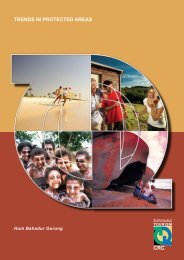icolls - Sustainable Tourism CRC
icolls - Sustainable Tourism CRC
icolls - Sustainable Tourism CRC
You also want an ePaper? Increase the reach of your titles
YUMPU automatically turns print PDFs into web optimized ePapers that Google loves.
ECOLOGY, THREATS AND MANAGEMENT OPTIONS FOR SMALL ESTUARIES AND ICOLLS<br />
information about the variability in source and consumer isotopic signatures in the proximity of the mouth of<br />
both systems.<br />
The primary sources of carbon sampled were riparian vegetation, mangroves, BFPOM, BCPOM, attached<br />
and free-floating algae and seston (suspended particulate organic matter). Riparian vegetation and mangroves<br />
were hand collected, while BFPOM and BCPOM samples were collected by sifting benthic sediments through a<br />
series of graded sieves (250 µm - 500 µm - 1 cm). BFPOM samples were obtained from the 250 µm sieve and<br />
BCPOM samples were collected from the 500 µm sieve. Using a scalpel blade and brush, attached algae were<br />
carefully scraped from all available surfaces, including mangrove pneumatophores, rocks and woody debris.<br />
Aquatic insects, crustaceans and small fish were collected using a dip net and a small purse seine net. Fish<br />
were also collected in a larger seine net (measurements required) and unbaited fish traps. Sediment-dwelling<br />
organisms, including bivalve molluscs and polychaete worms, were collected using a yabby pump. Mobile<br />
consumers such as crabs were opportunistically hand collected wherever possible.<br />
Upon collection, all samples were immediately placed in individually labelled zip-lock bags and stored on<br />
ice. For the smaller organisms collected, this approach has been shown to enable them time to void their guts to<br />
expedite processing in the laboratory (Bunn & Boon 1993; Beaudoin et al. 2001). Samples were frozen for<br />
transportation back to the laboratory.<br />
Laboratory Sample Processing<br />
In the laboratory, samples of riparian vegetation, BFPOM, BCPOM, attached algae and mangroves were rinsed<br />
with distilled water to wash away dirt and debris. All samples were dried in an oven at 60°C for at least 48 hours.<br />
Dried samples were pulverised in a puck and ring grinding mill for approximately 3 minutes, or until the sample<br />
had been reduced to a fine powder. Ground samples were subsequently stored in 5 ml vials and frozen prior to<br />
analysis.<br />
Trichopteran larvae were removed from their cases upon collection. All aquatic macroinvertebrates were<br />
rinsed and dried before being ground using a mortar and pestle. Individuals were ground whole, but ground<br />
individuals were often subsequently pooled to ensure that sample size was sufficient to enable isotopic analyses.<br />
The exoskeletons of all aquatic crustaceans were removed to ensure that accumulated calcium carbonate did not<br />
influence carbon isotopic values (Mihuc & Toetz 1994; Leggett et al. 1999; Beaudoin et al. 2001).<br />
Analytical Methods<br />
Samples were analysed using a continuous flow-isotope ratio mass spectrometer (Micromass Isoprime<br />
EuroVector EA300, Manchester, UK) at Griffith University. Isotope ratios are expressed as either δ13C or δ 15 N<br />
and relate to the ratio of 13C:12C and 14N:15N, respectively. Values were calculated according to the following<br />
equation:<br />
δ 13 C or δ 15 N = [(Rsample / Rstandard) - 1] x 1000<br />
where Rsample is the isotopic ratio for the sample and Rstandard is the isotopic ratio of the standard (PeeDee<br />
belemnite carbonate for δ13C and atmospheric N for δ 15 N).<br />
For abundant taxa, nitrogen isotope signatures were statistically compared between samples from Tallows<br />
and Belongil Creeks using one way ANOVAs (Sokal & Rohlf 1999).<br />
Food web analyses were conducted using IsoSource mixing model software (Phillips & Gregg 2003).<br />
Trophic fractionations of carbon and nitrogen signatures were set at 0.2‰ and 1.5‰ respectively, based on<br />
values reported in the stable isotope literature (Peterson & Fry 1987; McCutchan, Lewis, Kendall & McGrath<br />
2003; Hadwen & Bunn 2004).<br />
Results<br />
Community Composition<br />
The composition of the Tallows Creek food web was distinctly different from that of Belongil Creek. There were<br />
generally more species collected from Tallows Creek, although some of these additional taxa reflected the status<br />
of Tallows Creek at the time of sampling (closed) more so than the influence of the STP inputs. For example,<br />
numerous freshwater macroinvertebrates were collected from Tallows Creek, highlighting the low salinity and<br />
absence of tidal fluctuations in the system. In contrast, moderate tidal exchange in Belongil Creek ensured that<br />
only estuarine/marine taxa were present at the time when collections were made.<br />
28











